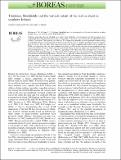Files in this item
Trimlines, blockfields and the vertical extent of the last ice sheet in southern Ireland
Item metadata
| dc.contributor.author | Ballantyne, Colin | |
| dc.contributor.author | Stone, John O. | |
| dc.date.accessioned | 2015-01-19T14:31:04Z | |
| dc.date.available | 2015-01-19T14:31:04Z | |
| dc.date.issued | 2015-04 | |
| dc.identifier | 162210320 | |
| dc.identifier | 51b1a5f9-a888-42b2-84db-a2a036e9d1df | |
| dc.identifier | 84925643193 | |
| dc.identifier | 000351852200002 | |
| dc.identifier.citation | Ballantyne , C & Stone , J O 2015 , ' Trimlines, blockfields and the vertical extent of the last ice sheet in southern Ireland ' , Boreas , vol. 44 , no. 2 , pp. 277-287 . https://doi.org/10.1111/bor.12109 | en |
| dc.identifier.issn | 0300-9483 | |
| dc.identifier.uri | https://hdl.handle.net/10023/6021 | |
| dc.description | The research reported here was supported by UK NERC grant NER/B/S/2001/0919 | en |
| dc.description.abstract | Trimlines separating glacially abraded lower slopes from blockfield-covered summits on Irish mountains have traditionally been interpreted as representing the upper limit of the last ice sheet during the Last Glacial Maximum (LGM). Cosmogenic 10Be exposure ages obtained for samples from glacially deposited perched boulders resting on blockfield debris on the summit area of Slievenamon (721 m a.s.l.) in southern Ireland demonstrate emplacement by the last Irish Ice Sheet (IIS), implying preservation of the blockfield under cold-based ice during the LGM, and supporting the view that trimlines throughout the British Isles represent former englacial thermal regime boundaries between a lower zone of warm-based sliding ice and an upper zone of cold-based ice. The youngest exposure age (22.6±1.1 or 21.0±0.9 ka, depending on the 10Be production rate employed) is statistically indistinguishable from the mean age (23.4±1.2 or 21.8±0.9 ka) obtained for two samples from ice-abraded bedrock at high ground on Blackstairs Mountain, 51 km to the east, and with published cosmogenic 36Cl ages. Collectively, these ages imply (i) early (24–21 ka) thinning of the last IIS and emergence of high ground in SE Ireland; (ii) relatively brief (1–3 ka) glacial occupation of southernmost Ireland during the LGM; (iii) decoupling of the Irish Sea Ice Stream and ice from the Irish midlands within a similar time frame; and (iv) that the southern fringe of Ireland was deglaciated before western and northern Ireland. | |
| dc.format.extent | 11 | |
| dc.format.extent | 989598 | |
| dc.language.iso | eng | |
| dc.relation.ispartof | Boreas | en |
| dc.subject | G Geography (General) | en |
| dc.subject | QE Geology | en |
| dc.subject | NDAS | en |
| dc.subject.lcc | G1 | en |
| dc.subject.lcc | QE | en |
| dc.title | Trimlines, blockfields and the vertical extent of the last ice sheet in southern Ireland | en |
| dc.type | Journal article | en |
| dc.contributor.institution | University of St Andrews. Geography & Sustainable Development | en |
| dc.identifier.doi | https://doi.org/10.1111/bor.12109 | |
| dc.description.status | Peer reviewed | en |
This item appears in the following Collection(s)
Items in the St Andrews Research Repository are protected by copyright, with all rights reserved, unless otherwise indicated.

